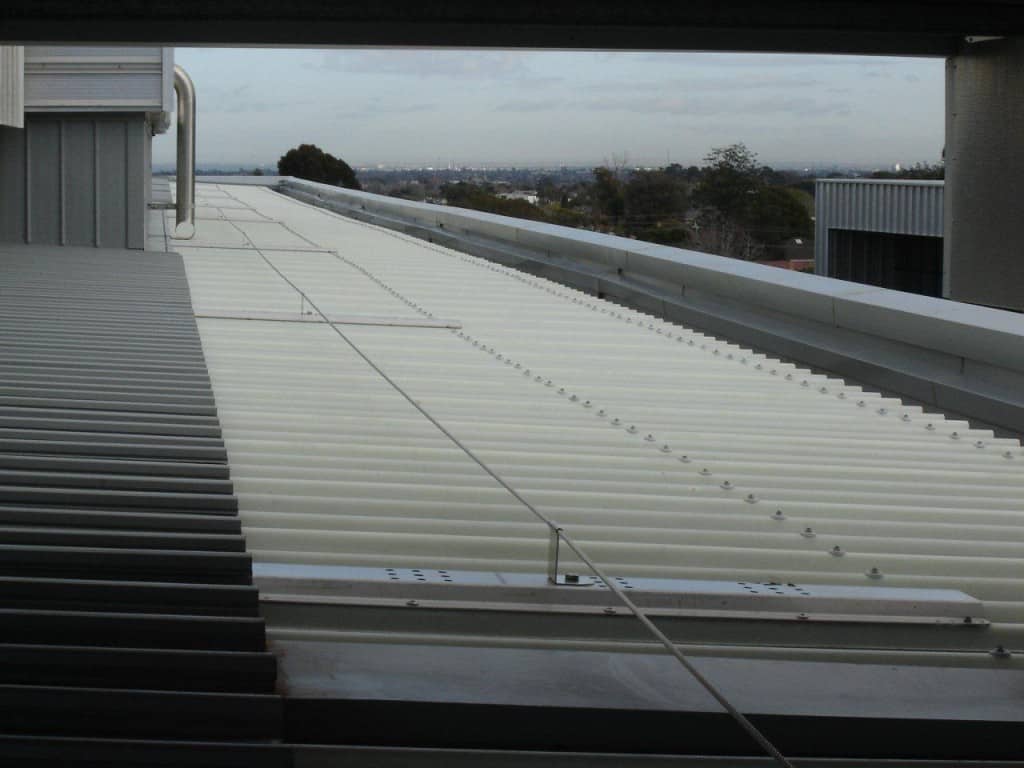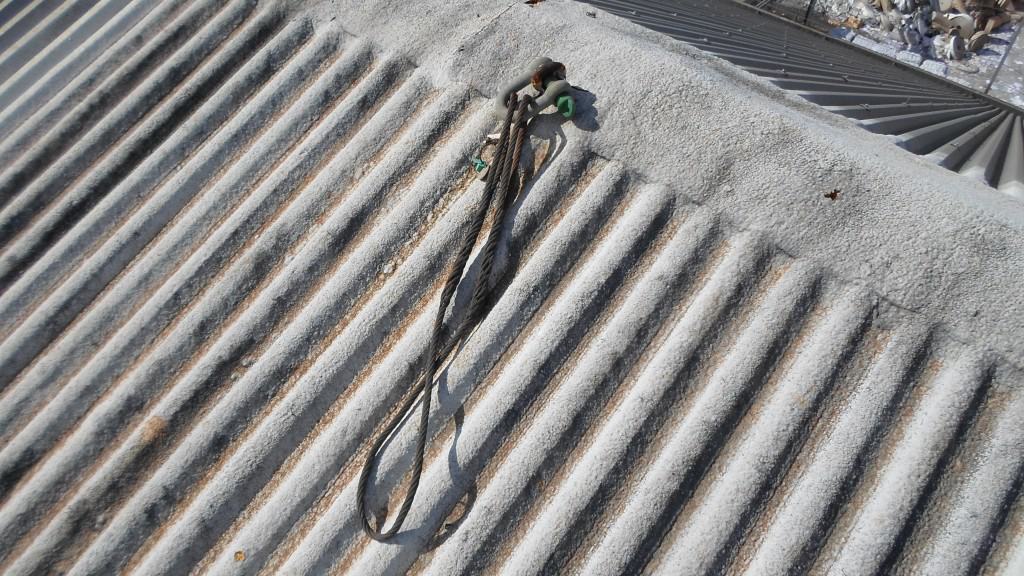How safe is this rooftop?
Metal roofing installations carry a lot of risk and builders must manage the hazards to ensure a rooftop is safe to work on. However, a lack of knowledge and regulation specific to fall prevention places workers at risk of serious injury every day.
“If you need to use that, you’ll almost certainly die,” says fall prevention expert and Workplace Access and Safety managing director Carl Sachs, pointing to a guardrail on the rooftop of a multi-storey Melbourne office block.
Fixed to flimsy aluminium flashing, the guardrail flies in the face of several mandatory and voluntary standards but, according to Carl, non-compliances are more the norm than the exception on Australia’s rooftops.
The problem, he says, is that height safety equipment installers need no training or qualifications and nobody is checking that their work really is capable of saving lives.
“Australians wouldn’t accept unqualified electricians wiring our houses but, as it stands, all you need is a ute, a credit card and a cordless drill to install the safety gear that stops us falling off skyscrapers.”
It’s a concern echoed by builders, roof plumbers and building surveyors. Paul Naylor of the Master Plumbers Association of NSW says roof plumbers and builders risk deadly falls on a daily basis.
“While due diligence principles can be applied and all care taken to ensure that height safety systems are adequate, without some form of regulation or certification, workers are placed at risk of serious injury every day due to a lack of knowledge and regulation specific to fall prevention,” he says.
The current Code of Practice for Managing the Risk of Falls at Workplaces refers to over nine separate Australian Codes and Australian/New Zealand Standards, and gives consideration to individual manufacturer requirements.
“Surely it makes sense to have the installation of engineered structures such as guardrails, anchor points and even access ladders carried out by a licensed specialist who has in-depth knowledge of the standards required and also experience in the practical application of installation.”
The maze of codes, regulations and standards dealing with fall prevention is all too familiar to Carl, who also represents the Master Builders Association on Australian Standards review committees.
“It’s a very technical field with serious legal ramifications and workplaces rightly rely on specialist contractors to do their jobs properly,” he explains.
“In many cases, they don’t; risking the safety of workers and exposing everyone else to hefty penalties and jail terms.”
Competence difficult to measure
WorkCover NSW Work Health and Safety Division general manager John Watson says competence is key, although this is often self-regulated.
“Installers of these systems would need to be competent,” John says.
“This requires installers to have thorough training, qualification or experience, the knowledge and skill to carry out the task. The basis of safe installation relates to designer/manufacturer instructions that must be followed when installing these systems.
“So the controller of the workplace can confirm with the installer if they are following manufacturers’ instructions and for them to demonstrate this. This may be in the form of safe operating procedures. It can also be confirmed that those individuals installing the system have received training in these procedures.
“Finally, questions that can be asked directly to the installers is whether they have installed this specific system, where they did this and how long ago.”
Since there is no industry-recognised training or qualification for fall prevention equipment installation, verifying installers’ competence can be tricky.

Call for mandatory accreditation
To help deal with safe work at heights compliance, Workplace Access and Safety runs regular seminars. Carl explains that attendees are desperate for the reassurance that formal qualifications would bring when engaging contractors.
His own firm has attained a variety of accreditations, including Registered Training Organisation (RTO) status, a specialist builder’s licence, and most recently, ISO9001 accreditation. Staff members also sit on Australian Standards review committees to stay ahead of industry developments.
While Carl agrees all of this is very marketable, he says it is critical that workplaces demand more information from contractors.
“Ask your contractors for a copy of their accreditations and check the details,” he recommends.
“You need to be sure the accreditation applies to the job you’re doing and that they were independently verified. Any shonky contractor can spend $500, fill in the blanks of an electronic ISO9001 system or generic off-the-shelf safety plan template, falsify their training records, issue a certificate themselves, sign it and claim compliance.
“Independent accreditation and certification by a reputable organisation like SAI Global and Bureau Veritas, which has been around for 180 years, means your contractor is actually doing what the system says it must be doing, and that the scope of the accreditation relates to the work.
“It’s not much use having a contractor whose ISO9001 scope is for general construction or fabrication installing equipment onsite.”
Checks and balances inadequate
In many cases, such as in Victoria, the building surveyor’s fit for occupancy inspection is expected to pick up non-compliant installations. Victorian state president of the Australian Institute of Building Surveyors (AIBS) Con Giazi says the organisation is lobbying the state government for urgent change.
“To those who say that a building surveyor should be able to pick up all non-compliances, I’d point out that building surveyors are only there on limited occasions and there are provisions for them to rely on certificates issues by qualified or competent installers.”
Given that no qualifications are required and certificates of installation could be issued by anyone, Con says building surveyors cannot assess the competency of installers.
“The building surveyor is not there as a site supervisor. At the end of the day, the principal contractor wears the responsibility. When self-regulation fails, it falls on those with deep pockets and, ultimately, the architect, engineer, builder and building surveyor.
“The AIBS is lobbying the Victorian government to have every practitioner – and their subcontractors – on site registered with the building practitioner’s board to add more rigour. While that may create extra work, it does provide credibility and makes each trade more accountable.”
As those whose lives literally hang in the balance, roof plumbers are also keen to see increased regulation.
“Having the structures installed, tested and certified by a licensed installer would give peace of mind to our plumbing members by knowing they could confidently work from or attach to engineered structures,” Paul says.

New push for safer fall prevention installations
Australian Rope Access Association founder Peter Ferguson says lax regulation has been a “bugbear” of his for many years but dangerous installations are becoming more common.
“There is no oversight and the installation sector is driven by speed, a quick buck and minimal control,” he says. “We have a crisis here. As more and more roof anchors are installed, we will begin to see more and more fatalities in line with the frightening US statistics, where harness-based systems dominate.”
Peter says the installation crisis is well-known but industry attempts to deal with it had failed to date.
“WorkSafe and the equipment manufacturers know there’s a problem but we have not been able to improve the competency of people designing and installing fall prevention systems.”
A group is currently being formed to build a proposal for the licensing of fall prevention installers and for mandatory training.
Have you checked your skin lately?
If you work outdoors on metal roofing installations, you are at a greater risk of developing melanoma and other skin cancers.
While many skin spots, freckles and moles are harmless, some are clear signs of skin cancer.
The good news is that skin cancer can almost always be cured; the catch is early detection.
The Cancer Council recommends that you check your own skin regularly, say every three months. You should see your GP if you have a spot, mole or unusual freckle that has changed in shape, size or colour; a sore that doesn’t heal; or a skin spot that you’re worried about.
Only around 10% of outdoor workers protect themselves adequately against the sun. Making small changes at work can greatly reduce your risk of skin cancer – wear a broad brimmed hat or a safety hat with neck flaps, opt for longer-style clothes, put on SPF30+ and wear a pair of sunglasses.
Mobile skin checks
If making an appointment to see your GP is a little difficult, talk to the team at Skin Patrol – it offers a mobile service that aims to save the lives of outdoor workers through the early and remote detection of melanoma and other skin cancers.
Skin Patrol uses a unique model that incorporates onsite doctors, digital imaging of suspicious cuts and remote dermatologist diagnosis. Since 2004, the company has seen over 10,000 construction and infrastructure workers, detecting over 80 possible melanomas, 300 superficial skin cancers and over 1500 cases of significant sun damage.
This summer, Skin Patrol is launching a new service where a suspicious lesion on a worker can get instant specialist diagnosis via an online image review, or an online video consultation. On top of this, they provide extensive one-on-one education around what to look for when checking your skin.
Around 42% of skin cancers on outdoor workers are found on legs and arms, highlighting the importance of wearing long sleeves and long pants when working on metal roofing installations.
